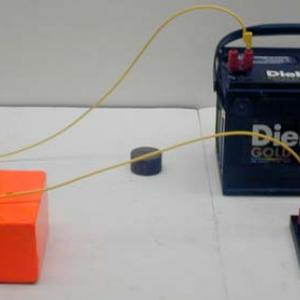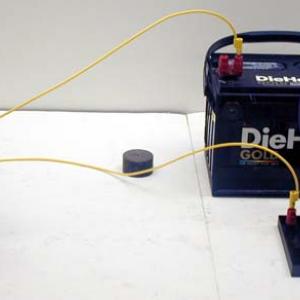College of Liberal Arts & Sciences
5H40.30 - Jumping Wires - Magnet and Wire
Take a wire from the positive pole of the 12 volt car battery to a key switch. Another wire from the key switch to the negative terminal of the battery. Run this wire through the poles of the horn magnet and hit the switch. Depending on the direction of the current the wire will either jump into or out of the magnet. The wooden block is just so that the wire sets up between the poles of the magnet better.
- Martin McCall, Paul Kinsler, Vijay Tymms, "Catapult Description of Magnetic Fields and Forces", TPT, Vol. 58, #6, Sept. 2020, p. 416.
- G. Donoso and C. L. Ladera, "The Expected but Well-Hidden EMF in the Jumping Wire Experiment and its Unexpected Role", TPT, Vol. 53, #9, Dec. 2015, p. 550.
- John Koser, "Magnetic Force Demo", TPT, Vol. 51, #5, May 2013, p. 260.
- H. K. Wong, "Levitated Homopolar Motor", TPT, Vol. 47, #1, Jan. 2009, p. 124.
- Sean Stewart, "Force on a Current-Carrying Wire", TPT, Vol. 44, #4, Apr. 2006, p. 245.
- Yaakov Kraftmakher, "Classroom Demonstration of Magnetic Force", TPT, Vol. 42, #8, Nov. 2004, p. 500.
- Bruce Bernero, "A Demonstration of Magnetic Force upon a Current-Carrying Wire", TPT, Vol. 25, #2, Feb. 1987, p. 88.
- James M. Piowaty, "A Simple Magnetic Force Experiment", TPT, Vol. 18, #8, Nov. 1980, p. 598.
- Donald S. Ainslie, "Electromagnetic Effects with a Coil and Rubber Bands", TPT, Vol. 17, #3. Mar. 1979, p. 206.
- Herbert H. Gottlieb, "Force on Current Carrying Aluminum Foil", TPT, Vol. 5, #8, Nov. 1967, p. 387, aslo A Potpourri of Physics Teaching Ideas - Electricity and Magnetism, p. 156.
- Robert M. Donne, "F=q v x B: A Simple Demonstration", TPT, Vol. 12, #9, Dec. 1974, p. 574.
- Marco Finazzi and Maurizio Zani, "Origin of the Laplace Force Applied to a Current-Carrying Wire Immersed in a Magnetic Field", TPT, Vol. 61, #4, Apr. 2023, p. 286.
- A. C. English, "Force on a Wire in a Magnetic Field", AJP, Vol. 35, #4, Apr. 1967, p. 326.
- H. W. Dosso and R. H. Vidal, "Magnetic Field Demonstrations", AJP, Vol. 31, #1, Jan. 1963, p. 59.
- Ei-12: Freier and Anderson, A Demonstration Handbook for Physics.
- B-020: "Wire Current-Vibrat. Filament", DICK and RAE Physics Demo Notebook.
- Yaakov Kraftmakher, "1.10, Magnetic Force", Experiments and Demonstrations in Physics, ISBN 981-256-602-3, p. 36.
- David Kutliroff, "85, A Horseshoe Magnet and a Long Current-Bearing Wire Can Illustrate that Magnetic Fields Do Exist Around Electric Currents", 101 Classroom Demonstrations and Experiment For Teaching Physics, p. 189.
- Borislaw Bilash II and David Maiullo, "Jumping Wire", A Demo a Day: A Year of Physics of Demonstrations, p. 292.
- "Force on a Current Carrying Wire in a Magnetic Field", PIRA Newsletter, Vol. 3, #17.
- "Motor Effect", Exploratorium Science Snackbook, p. 70.1 - 70.2.
- "Magnetic Force on an Electric Current",Physics From the Junk Drawer, 3rd Edition, The Science House, North Carolina State University, p. 40.
Disclaimer: These demonstrations are provided only for illustrative use by persons affiliated with The University of Iowa and only under the direction of a trained instructor or physicist. The University of Iowa is not responsible for demonstrations performed by those using their own equipment or who choose to use this reference material for their own purpose. The demonstrations included here are within the public domain and can be found in materials contained in libraries, bookstores, and through electronic sources. Performing all or any portion of any of these demonstrations, with or without revisions not depicted here entails inherent risks. These risks include, without limitation, bodily injury (and possibly death), including risks to health that may be temporary or permanent and that may exacerbate a pre-existing medical condition; and property loss or damage. Anyone performing any part of these demonstrations, even with revisions, knowingly and voluntarily assumes all risks associated with them.

